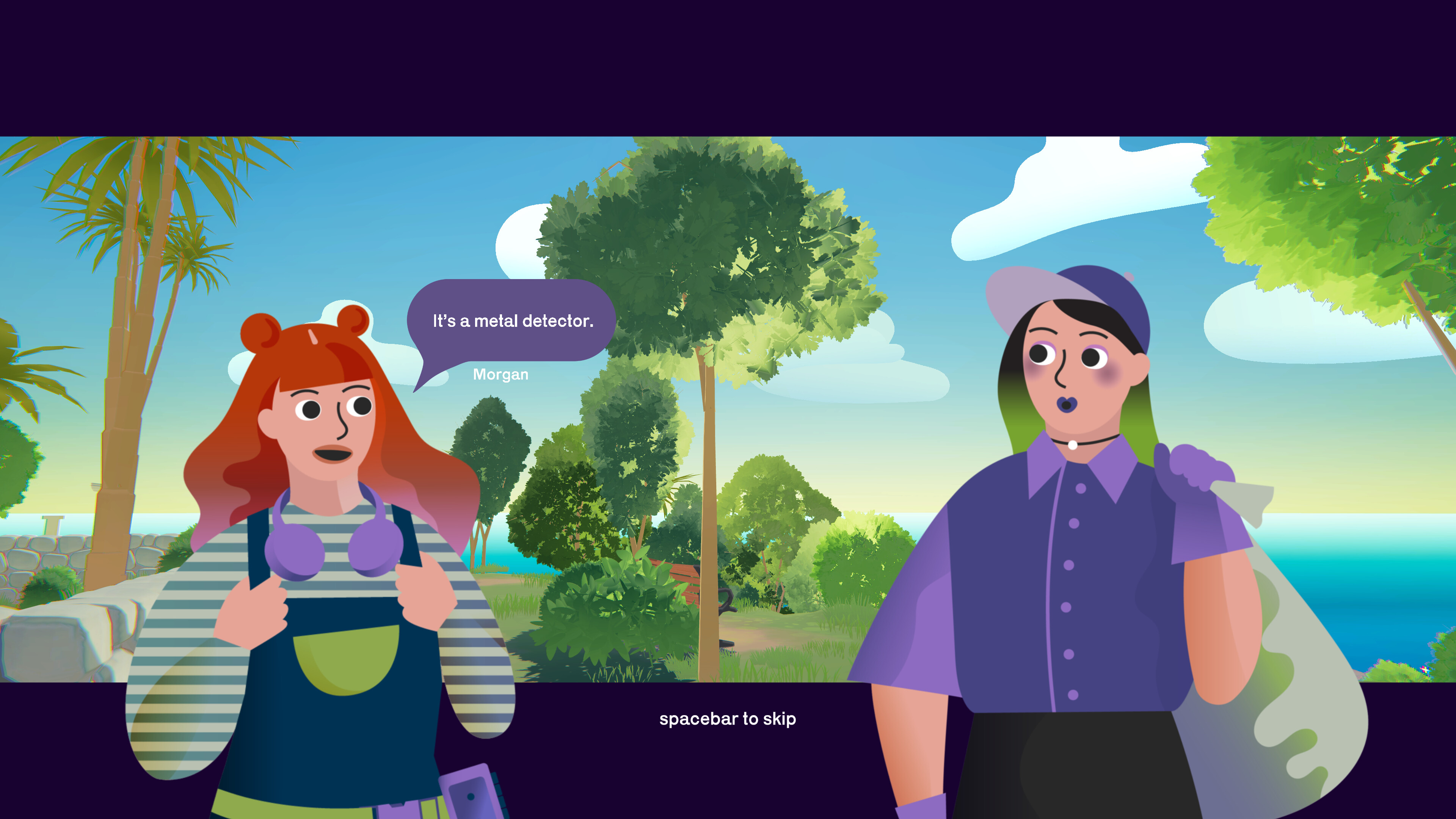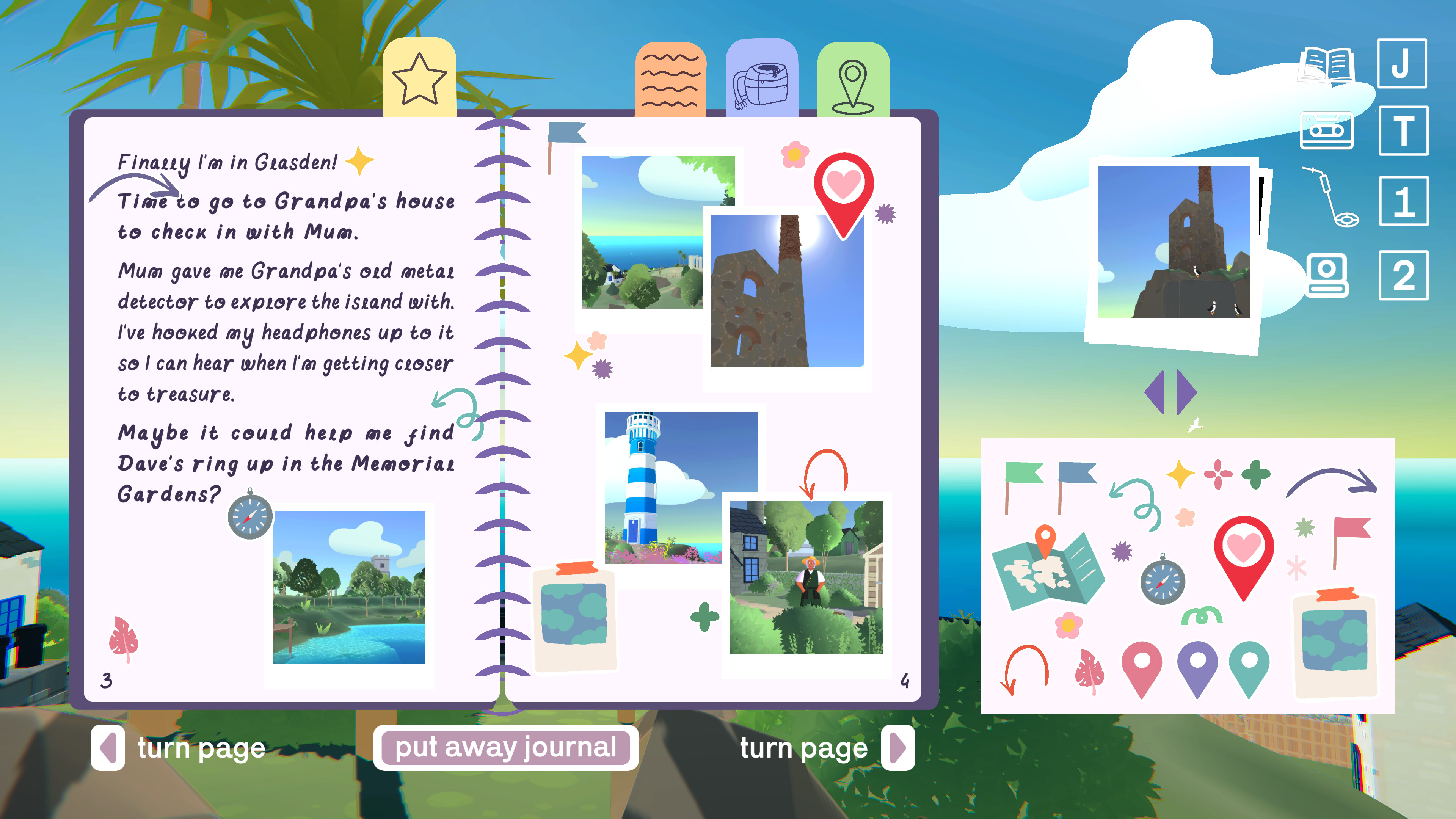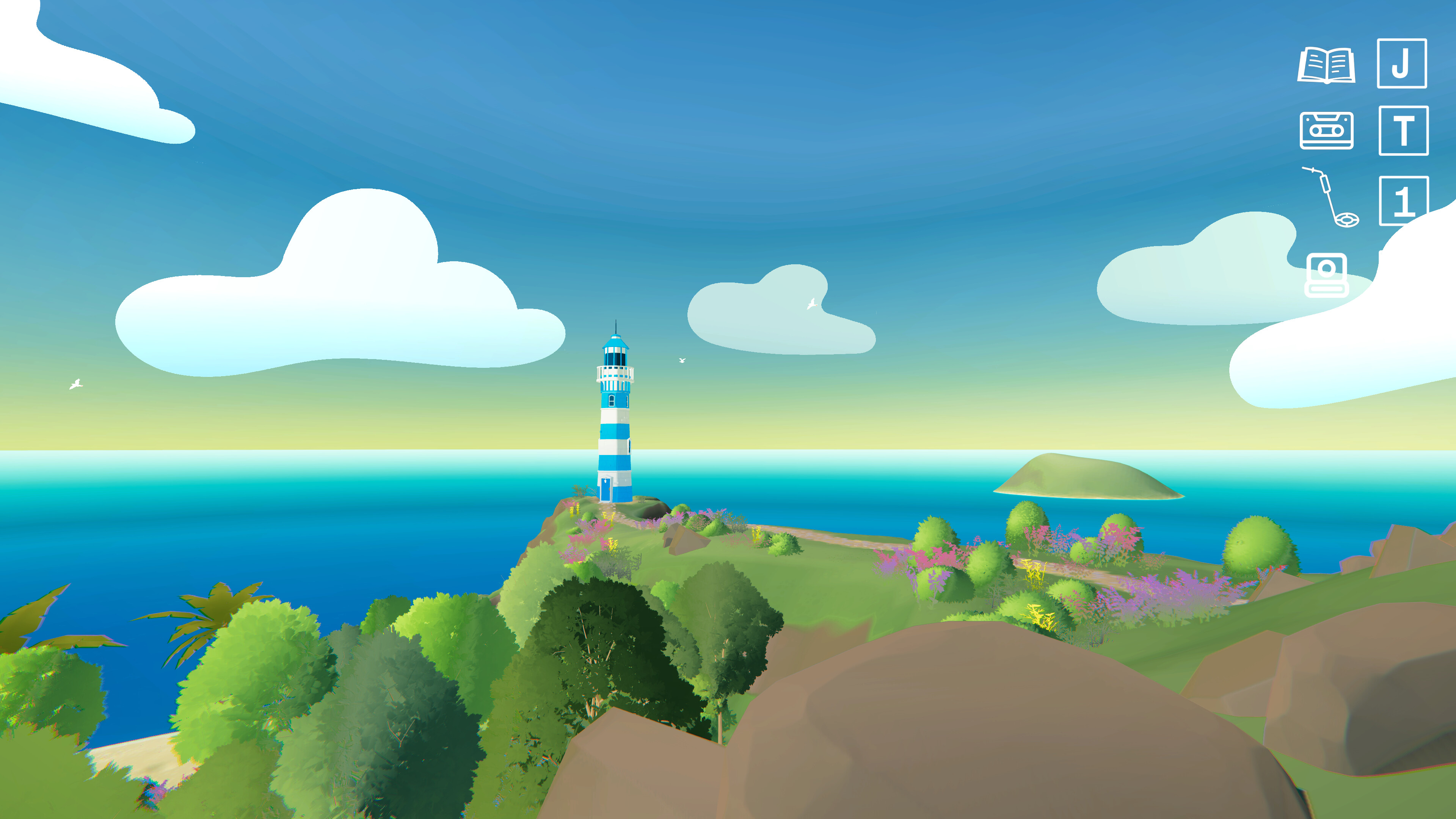‘Morgan: Metal Detective’ is a cosy, first person metal detector adventure game, where you reunite residents of the beautiful Cornish island of Glasden with things they have lost. And with your late Grandpa's help, maybe restore magic along the way.
![]()

Coming soon on Steam, wishlist now. Downloadable for Windows and Mac.
Morgan is currently being developed by myself and Holly Hudson. It was showcased publicly at EGX, 12-15 October 2023.
Interview for press:
How did the idea of Morgan: Metal Detective first come about between the two of you?
[Harvey]: I keep a running Google Doc of game ideas and one of them was just “mudlarking” (when you scour the beaches of an estuary for finds). I played around with this a little bit and thought about a murder mystery where you accidentally discover a murder weapon while mudlarking and are embroiled in the acts of a vicious London gang… but I quickly got rid of that idea.
One of things I liked about a game involving mudlarking was the premise of discovering items hidden just below the surface; the idea that there’s history hidden under every footstep. Then it struck me, why limit ourselves to the banks for a river? Why not expand out to anywhere? Metal detecting.
I pitched this basic idea to Holly, “first person game about metal detecting”, and we quickly picked up and ran with it.
The way our course is structured is that we’re meant to pitch three different ideas to a panel of industry experts, and use their feedback to inform our choice of which one we develop. Although we pitched two other game ideas, we’d already decided that we were invested in this one concept, initially named “Searching for Treasure”.
Early on, we joined up with the game’s writer, Ruby Abbiss, and started to talk about how we could build a narrative around metal detecting. We envisaged that a rewarding game loop would be listening or finding clues then use these to pinpoint a location where a treasure could be found, then return this item to its rightful owner for an emotional payoff. I don’t think we’ve ever lost sight of this goal!
![]()
What were your main reference points through its development?
[Harvey]: These were super clear for us really early on. Our main touchstones have always been ‘Firewatch’ and ‘Alba: A Wildlife Adventure’. We wanted to create a unique blend of the two, but also add in the core mechanic of metal detecting.
From an art style perspective, we were certainly inspired by the chunky models of ‘Firewatch’ and the low poly gradients of ‘Alba’, but we were also inspired by ustwo’s previous title, ‘Assemble with Care’. We loved how each of the objects to disassemble, then carefully assemble, are lovingly designed. In addition, we adored its hand drawn character art style. Another strong reference point for us was the design of the magical, soft 3D environments in ‘Sky: Children of the Light’.
[Holly]: We also took inspiration from the likes of ‘Untitled Goose Game’, ‘Ooblets’ and ‘Frog Detective’. Each with a unique style, these games utilize flat-shading and lower poly models to flesh out their worlds and visually narrate their stories. As a two-person team, there were many time constraints Harvey and I had to consider, one of which being how we could efficiently create 3D assets in a small amount of time. Using these flat-shaded, minimalist looks as inspiration, we were able to build a low-poly library of assets that use block colours and gradients. This enabled us to produce the assets we needed within our production schedule.
![]()
Is there any element of the game that each of you found most challenging to make right?
[Harvey]: The most difficult element to get right has certainly been how metal detecting works, looks, interacts with the terrain and around the story elements. Early on in development we got obsessed with the idea of keys. One key you found underground led to a safe, which contained a key, giving you access to a beach hut, which contained another key that opened a gate in a cave… We got carried away.
What really helped us was to think about what items which each of the game’s characters could desperately want returned, and weave a larger narrative into that.
From a technical perspective, we went through several iterations of how the metal detector system would work, and interact with the game world. We initially played around with a third party system, Digger which literally rips holes in the Unity terrain system. However, we could not get this system to operate in a performant way, so had to abandon this approach.
We played around with another third party system, See-Through Shader but couldn’t find a reliable way to get this to work with the terrain system.
Next we played around with a system which uses a second camera to show a hole on the ground, much like ‘Portal’. But this felt like overkill.
We ultimately ended up with a stencil shader system which renders layers and materials such that we can fake a hole intersecting with the terrain, without actually making a hole in the terrain. A huge thanks to fellow National Film and Television School Games student, Thomas Porta for masterminding this solution.
![]()
However, quite a long way into development, we let players dig wherever they wanted. Some people found this quite unsatisfying when they didn’t hit quite the right spot to find the treasure (too much like real metal detecting). So the system we landed on was the game tells you when you can dig, and you will always find treasure, maybe that treasure is an old can, but you never get the disappointment of an empty hole.
What is it in the game that you feel most proud of?
[Harvey]: I’m really proud of how the game feels to play. From playtesting, we’ve seen that players LOVE metal detecting, maybe to an obsessive degree. I’m not sure if we anticipated how content players would be just searching for stuff hidden underground. In some cases, we’ve developed these intricate quests and storylines, but the players weren’t interested. Good stuff.
[Holly]: I’m also so proud of the world we’ve created on this little Cornish island. We wanted to evoke a sense of child-like wonder in this game, so it is really rewarding seeing the player's enthusiasm to want to run around and explore the beauty and mysteries of the island!
Is there anyone you had specifically in mind as the audience while creating the game?
[Harvey]: We think that cosy games are a really powerful tool to help people relax, decompress and switch off. We wanted to create a place where people can do that. No stress, no danger, just get out your metal detector and explore. I guess it was anyone who feels like they need that space?
[Holly]: I’m a huge cosy game fan, and have been loving the recent wave of wholesome titles such as ‘Mail Time’, ‘Ooblets’, and ‘Bear and Breakfast’. When Harvey pitched me the initial metal detecting idea, we could see how this meditative mechanic would really lend itself to the stress-free and calming nature of cosy games. The games market is saturated with high-adrenaline games that lean on the idea of fight or flight, but with ‘Morgan: Metal Detective’ we wanted to reach out to audiences that crave emotionally and socially engaging games through soothing visuals and gentle gameplay mechanics.
![]()
Anything else you want to say?
[Harvey]: I quit my job in tax consultancy to pursue a career in video game development. I decided to study the Video Game Design and Development MA programme at the National Film and Television School (NFTS). I’m so happy that I did. The school has enabled me to work alongside the most talented artists, programmers, writers, composers, sound designers, producers, and receive feedback from some truly brilliant tutors. I’m deeply thankful to the faculty and all my fellow students. If you’re reading this as someone who is struggling to make their way into the games industry but is bubbling with interesting ideas, please consider studying at the NFTS.
[Holly]: I’ve been very fortunate in that I’ve been surrounded and supported by many talented, passionate people within the games industry. It’s been particularly inspiring to see an increasing presence of women in leadership positions. Seeing women lead with creativity and determination is not only empowering but also a demonstration of the industry's steps towards a more diverse and inclusive space. It is a reminder that the games industry is a place of opportunity for anyone!
![]()
Interview for press:
How did the idea of Morgan: Metal Detective first come about between the two of you?
[Harvey]: I keep a running Google Doc of game ideas and one of them was just “mudlarking” (when you scour the beaches of an estuary for finds). I played around with this a little bit and thought about a murder mystery where you accidentally discover a murder weapon while mudlarking and are embroiled in the acts of a vicious London gang… but I quickly got rid of that idea.
One of things I liked about a game involving mudlarking was the premise of discovering items hidden just below the surface; the idea that there’s history hidden under every footstep. Then it struck me, why limit ourselves to the banks for a river? Why not expand out to anywhere? Metal detecting.
I pitched this basic idea to Holly, “first person game about metal detecting”, and we quickly picked up and ran with it.
The way our course is structured is that we’re meant to pitch three different ideas to a panel of industry experts, and use their feedback to inform our choice of which one we develop. Although we pitched two other game ideas, we’d already decided that we were invested in this one concept, initially named “Searching for Treasure”.
Early on, we joined up with the game’s writer, Ruby Abbiss, and started to talk about how we could build a narrative around metal detecting. We envisaged that a rewarding game loop would be listening or finding clues then use these to pinpoint a location where a treasure could be found, then return this item to its rightful owner for an emotional payoff. I don’t think we’ve ever lost sight of this goal!

What were your main reference points through its development?
[Harvey]: These were super clear for us really early on. Our main touchstones have always been ‘Firewatch’ and ‘Alba: A Wildlife Adventure’. We wanted to create a unique blend of the two, but also add in the core mechanic of metal detecting.
From an art style perspective, we were certainly inspired by the chunky models of ‘Firewatch’ and the low poly gradients of ‘Alba’, but we were also inspired by ustwo’s previous title, ‘Assemble with Care’. We loved how each of the objects to disassemble, then carefully assemble, are lovingly designed. In addition, we adored its hand drawn character art style. Another strong reference point for us was the design of the magical, soft 3D environments in ‘Sky: Children of the Light’.
[Holly]: We also took inspiration from the likes of ‘Untitled Goose Game’, ‘Ooblets’ and ‘Frog Detective’. Each with a unique style, these games utilize flat-shading and lower poly models to flesh out their worlds and visually narrate their stories. As a two-person team, there were many time constraints Harvey and I had to consider, one of which being how we could efficiently create 3D assets in a small amount of time. Using these flat-shaded, minimalist looks as inspiration, we were able to build a low-poly library of assets that use block colours and gradients. This enabled us to produce the assets we needed within our production schedule.

Is there any element of the game that each of you found most challenging to make right?
[Harvey]: The most difficult element to get right has certainly been how metal detecting works, looks, interacts with the terrain and around the story elements. Early on in development we got obsessed with the idea of keys. One key you found underground led to a safe, which contained a key, giving you access to a beach hut, which contained another key that opened a gate in a cave… We got carried away.
What really helped us was to think about what items which each of the game’s characters could desperately want returned, and weave a larger narrative into that.
From a technical perspective, we went through several iterations of how the metal detector system would work, and interact with the game world. We initially played around with a third party system, Digger which literally rips holes in the Unity terrain system. However, we could not get this system to operate in a performant way, so had to abandon this approach.
We played around with another third party system, See-Through Shader but couldn’t find a reliable way to get this to work with the terrain system.
Next we played around with a system which uses a second camera to show a hole on the ground, much like ‘Portal’. But this felt like overkill.
We ultimately ended up with a stencil shader system which renders layers and materials such that we can fake a hole intersecting with the terrain, without actually making a hole in the terrain. A huge thanks to fellow National Film and Television School Games student, Thomas Porta for masterminding this solution.

However, quite a long way into development, we let players dig wherever they wanted. Some people found this quite unsatisfying when they didn’t hit quite the right spot to find the treasure (too much like real metal detecting). So the system we landed on was the game tells you when you can dig, and you will always find treasure, maybe that treasure is an old can, but you never get the disappointment of an empty hole.
What is it in the game that you feel most proud of?
[Harvey]: I’m really proud of how the game feels to play. From playtesting, we’ve seen that players LOVE metal detecting, maybe to an obsessive degree. I’m not sure if we anticipated how content players would be just searching for stuff hidden underground. In some cases, we’ve developed these intricate quests and storylines, but the players weren’t interested. Good stuff.
[Holly]: I’m also so proud of the world we’ve created on this little Cornish island. We wanted to evoke a sense of child-like wonder in this game, so it is really rewarding seeing the player's enthusiasm to want to run around and explore the beauty and mysteries of the island!
Is there anyone you had specifically in mind as the audience while creating the game?
[Harvey]: We think that cosy games are a really powerful tool to help people relax, decompress and switch off. We wanted to create a place where people can do that. No stress, no danger, just get out your metal detector and explore. I guess it was anyone who feels like they need that space?
[Holly]: I’m a huge cosy game fan, and have been loving the recent wave of wholesome titles such as ‘Mail Time’, ‘Ooblets’, and ‘Bear and Breakfast’. When Harvey pitched me the initial metal detecting idea, we could see how this meditative mechanic would really lend itself to the stress-free and calming nature of cosy games. The games market is saturated with high-adrenaline games that lean on the idea of fight or flight, but with ‘Morgan: Metal Detective’ we wanted to reach out to audiences that crave emotionally and socially engaging games through soothing visuals and gentle gameplay mechanics.

Anything else you want to say?
[Harvey]: I quit my job in tax consultancy to pursue a career in video game development. I decided to study the Video Game Design and Development MA programme at the National Film and Television School (NFTS). I’m so happy that I did. The school has enabled me to work alongside the most talented artists, programmers, writers, composers, sound designers, producers, and receive feedback from some truly brilliant tutors. I’m deeply thankful to the faculty and all my fellow students. If you’re reading this as someone who is struggling to make their way into the games industry but is bubbling with interesting ideas, please consider studying at the NFTS.
[Holly]: I’ve been very fortunate in that I’ve been surrounded and supported by many talented, passionate people within the games industry. It’s been particularly inspiring to see an increasing presence of women in leadership positions. Seeing women lead with creativity and determination is not only empowering but also a demonstration of the industry's steps towards a more diverse and inclusive space. It is a reminder that the games industry is a place of opportunity for anyone!
